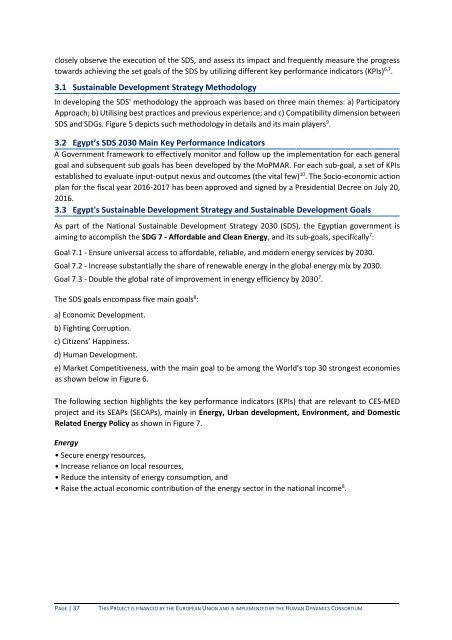180917_CES-MED_National_Report_Egypt_FINAL2rev
Create successful ePaper yourself
Turn your PDF publications into a flip-book with our unique Google optimized e-Paper software.
closely observe the execution of the SDS, and assess its impact and frequently measure the progress<br />
towards achieving the set goals of the SDS by utilizing different key performance indicators (KPIs) 6,7 .<br />
3.1 Sustainable Development Strategy Methodology<br />
In developing the SDS' methodology the approach was based on three main themes: a) Participatory<br />
Approach; b) Utilising best practices and previous experience; and c) Compatibility dimension between<br />
SDS and SDGs. Figure 5 depicts such methodology in details and its main players 9 .<br />
3.2 <strong>Egypt</strong>’s SDS 2030 Main Key Performance Indicators<br />
A Government framework to effectively monitor and follow up the implementation for each general<br />
goal and subsequent sub goals has been developed by the MoPMAR. For each sub-goal, a set of KPIs<br />
established to evaluate input-output nexus and outcomes (the vital few) 10 . The Socio-economic action<br />
plan for the fiscal year 2016-2017 has been approved and signed by a Presidential Decree on July 20,<br />
2016.<br />
3.3 <strong>Egypt</strong>'s Sustainable Development Strategy and Sustainable Development Goals<br />
As part of the <strong>National</strong> Sustainable Development Strategy 2030 (SDS), the <strong>Egypt</strong>ian government is<br />
aiming to accomplish the SDG 7 - Affordable and Clean Energy, and its sub-goals, specifically 7 :<br />
Goal 7.1 - Ensure universal access to affordable, reliable, and modern energy services by 2030.<br />
Goal 7.2 - Increase substantially the share of renewable energy in the global energy mix by 2030.<br />
Goal 7.3 - Double the global rate of improvement in energy efficiency by 2030 7 .<br />
The SDS goals encompass five main goals 8 :<br />
a) Economic Development.<br />
b) Fighting Corruption.<br />
c) Citizens’ Happiness.<br />
d) Human Development.<br />
e) Market Competitiveness, with the main goal to be among the World’s top 30 strongest economies<br />
as shown below in Figure 6.<br />
The following section highlights the key performance indicators (KPIs) that are relevant to <strong>CES</strong>-<strong>MED</strong><br />
project and its SEAPs (SECAPs), mainly in Energy, Urban development, Environment, and Domestic<br />
Related Energy Policy as shown in Figure 7.<br />
Energy<br />
• Secure energy resources,<br />
• Increase reliance on local resources,<br />
• Reduce the intensity of energy consumption, and<br />
• Raise the actual economic contribution of the energy sector in the national income 8 .<br />
PAGE | 37<br />
THIS PROJECT IS FINANCED BY THE EUROPEAN UNION AND IS IMPLEMENTED BY THE HUMAN DYNAMICS CONSORTIUM

















